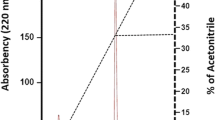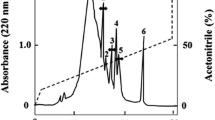Abstract
Leuconostoc pseudomesenteroides 607, isolated from persimmon fruit, was found to have high inhibitory activity against Listeria monocytogenes and several other Gram-positive bacteria. Inhibitory substances were purified from culture supernatant by ion-exchange chromatography, Sep-Pak C18 cartridge, and reverse-phase high-performance liquid chromatography (RP-HPLC). Two antibacterial peptides were observed during the purification procedures. One of these peptides had a molecular size of 4623.05 Da and a partial N-terminal amino acid sequence of NH2-KNYGNGVHxTKKGxS, in which the YGNGV motif is specific for class IIa bacteriocins. A BLAST search revealed that this bacteriocin was similar to leucocin C from Leuconostoc mesenteroides. Leucocin C-specific primers were designed and a single PCR product was amplified. Analysis of the nucleotide sequence has revealed a putative peptide differing by only one amino acid residue from the sequence of leucocin C. No identical peptide or protein has been reported in the literature, and this peptide, termed leucocin C-607, was therefore considered to be a new variant of leucocin C produced by Leuc. pseudomesenteroides 607. Another antibacterial peptide purified from the same culture supernatant had a molecular size of 3007.7 or 3121.97 Da. However, detailed information regarding this second peptide remains to be determined. Distinct characteristics, such as heat stability and inhibitory spectrum, were observed for the two bacteriocins produced by Leuc. pseudomesenteroides 607. These results suggested that Leuc. pseudomesenteroides 607 produces leucocin C-607 along with another unknown bacteriocin.




Similar content being viewed by others
References
Mokoena MP (2017) Lactic acid bacteria and their bacteriocins: classification, biosynthesis and applications against uropathogens: a mini-review. Molecules 22(8). https://doi.org/10.3390/molecules22081255
Kaškonienė V, Stankevičius M, Bimbiraitė-Survilienė K, Naujokaitytė G, Šernienė L, Mulkytė K, Malakauskas M, Maruška A (2017) Current state of purification, isolation and analysis of bacteriocins produced by lactic acid bacteria. Appl Microbiol Biotechnol 101(4):1323–1335. https://doi.org/10.1007/s00253-017-8088-9
Alvarez-Sieiro P, Montalbán-López M, Mu D, Kuipers OP (2016) Bacteriocins of lactic acid bacteria: extending the family. Appl Microbiol Biotechnol 100(7):2939–2951. https://doi.org/10.1007/s00253-016-7343-9
Nishie M, Nagao J, Sonomoto K (2012) Antibacterial peptides "bacteriocins": an overview of their diverse characteristics and applications. Biocontrol Sci 17(1):1–16. https://doi.org/10.4265/bio.17.1
Drider D, Fimland G, Héchard Y, McMullen LM, Prévost H (2006) The continuing story of class IIa bacteriocins. Microbiol Mol Biol Rev 70(2):564–582. https://doi.org/10.1128/MMBR.00016-05
Arakawa K, Yoshida S, Aikawa H, Hano C, Bolormaa T, Burenjargal S, Miyamoto T (2016) Production of a bacteriocin-like inhibitory substance by Leuconostoc mesenteroides subsp. dextranicum 213M0 isolated from Mongolian fermented mare milk, airag. Anim Sci J 87(3):449–456. https://doi.org/10.1111/asj.12445
Chang JY, Lee HJ, Chang HC (2007) Identification of the agent from Lactobacillus plantarum KFRI464 that enhances bacteriocin production by Leuconostoc citreum GJ7. J Appl Microbiol 103(6):2504–2515. https://doi.org/10.1111/j.1365-2672.2007.03543.x
Felix JV, Papathanasopoulos MA, Smith AA, von Holy A, Hastings JW (1994) Characterization of leucocin B-Ta11a: a bacteriocin from Leuconostoc carnosum Ta11a isolated from meat. Curr Microbiol 29(4):207–212. https://doi.org/10.1007/BF01570155
Hastings JW, Sailer M, Johnson K, Roy KL, Vederas JC, Stiles ME (1991) Characterization of leucocin A-UAL 187 and cloning of the bacteriocin gene from Leuconostoc gelidum. J Bacteriol 173(23):7491–7500. https://doi.org/10.1128/jb.173.23.7491-7500.1991
Héchard Y, Dérijard B, Letellier F, Cenatiempo Y (1992) Characterization and purification of mesentericin Y105, an anti-Listeria bacteriocin from Leuconostoc mesenteroides. J Gen Microbiol 138(12):2725–2731. https://doi.org/10.1099/00221287-138-12-2725
Makhloufi KM, Carré-Mlouka A, Peduzzi J, Lombard C, van Reenen CA, Dicks LM, Rebuffat S (2013) Characterization of leucocin B-KM432Bz from Leuconostoc pseudomesenteroides isolated from boza, and comparison of its efficiency to pediocin PA-1. PLoS One 8(8):e70484. https://doi.org/10.1371/journal.pone.0070484
Masuda Y, Ono H, Kitagawa H, Ito H, Mu F, Sawa N, Zendo T, Sonomoto K (2011) Identification and characterization of leucocyclicin Q, a novel cyclic bacteriocin produced by Leuconostoc mesenteroides TK41401. Appl Environ Microbiol 77(22):8164–8170. https://doi.org/10.1128/AEM.06348-11
Papathanasopoulos MA, Krier F, Revol-Junelles AM, Lefebvre G, Le Caer JP, von Holy A, Hastings JW (1997) Multiple bacteriocin production by Leuconostoc mesenteroides TA33a and other Leuconostoc/Weissella strains. Curr Microbiol 35(6):331–335. https://doi.org/10.1007/s002849900264
Sawa N, Okamura K, Zendo T, Himeno K, Nakayama J, Sonomoto K (2010) Identification and characterization of novel multiple bacteriocins produced by Leuconostoc pseudomesenteroides QU 15. J Appl Microbiol 109(1):282–291. https://doi.org/10.1111/j.1365-2672.2009.04653.x
Shi F, Wang Y, Li Y, Wang X (2016) Mode of action of leucocin K7 produced by Leuconostoc mesenteroides K7 against Listeria monocytogenes and its potential in milk preservation. Biotechnol Lett 38(9):1551–1557. https://doi.org/10.1007/s10529-016-2127-y
Wan X, Saris PE, Takala TM (2015) Genetic characterization and expression of leucocin B, a class IId bacteriocin from Leuconostoc carnosum 4010. Res Microbiol 166(6):494–503. https://doi.org/10.1016/j.resmic.2015.04.003
Xiraphi N, Georgalaki M, Rantsiou K, Cocolin L, Tsakalidou E, Drosinos EH (2008) Purification and characterization of a bacteriocin produced by Leuconostoc mesenteroides E131. Meat Sci 80(2):194–203. https://doi.org/10.1016/j.meatsci.2007.11.020
Kim DW, Choi SH, Kang A, Nam SH, Kim RN, Kim A, Kim DS, Park HS (2011) Genome Sequence of Leuconostoc pseudomesenteroides KCTC 3652. J Bacteriol 193(16):4299. https://doi.org/10.1128/JB.05433-11
Leong KH, Chen YS, Pan SF, Chen JJ, Wu HC, Chang YC, Yanagida F (2014) Diversity of lactic acid bacteria associated with fresh coffee cherries in Taiwan. Curr Microbiol 68(4):440–447. https://doi.org/10.1007/s00284-013-0495-2
Papalexandratou Z, Camu N, Falony G, De Vuyst L (2011) Comparison of the bacterial species diversity of spontaneous cocoa bean fermentations carried out at selected farms in Ivory Coast and Brazil. Food Microbiol 28(5):964–973. https://doi.org/10.1016/j.fm.2011.01.010
Pedersen TB, Kot WP, Hansen LH, Sørensen SJ, Broadbent JR, Vogensen FK, Ardö Y (2014) Genome sequences of two Leuconostoc pseudomesenteroides strains isolated from Danish dairy starter cultures. Genome Announc 2(3). https://doi.org/10.1128/genomeA.00485-14
Meslier V, Loux V, Renault P (2012) Genome sequence of Leuconostoc pseudomesenteroides strain 4882, isolated from a dairy starter culture. J Bacteriol 194(23):6637. https://doi.org/10.1128/JB.01696-12
de Man JC, Rogosa M, Sharpe ME (1960) A medium for the cultivation of lactobacilli. J Appl Microbiol 23(1):130–135
Srionnual S, Yanagida F, Lin LH, Hsiao KN, Chen YS (2007) Weissellicin 110, a newly discovered bacteriocin from Weissella cibaria 110, isolated from plaa-som, a fermented fish product from Thailand. Appl Environ Microbiol 73(7):2247–2250. https://doi.org/10.1128/AEM.02484-06
Yanagida F, Chen YS, Shinohara T (2006) Searching for bacteriocin-producing lactic acid bacteria in soil. J Gen Appl Microbiol 52(1):21–28. https://doi.org/10.2323/jgam.52.21
Schillinger U, Lücke FK (1989) Antibacterial activity of Lactobacillus sake isolated from meat. Appl Environ Microbiol 55(8):1901–1906
Papathanasopoulos MA, Krier F, Revol-Junelles AM, Lefebvre G, Le Caer JP, von Holy A, Hastings JW (2007) Multiple bacteriocin production by Leuconostoc mesenteroides TA33a and other Leuconostoc/Weissella strains. Curr Microbiol 199735(6):331–335
Papathanasopoulos MA, Dykes GA, Revol-Junelles AM, Delfour A, von Holy A, Hastings JW (1998) Sequence and structural relationships of leucocins A-, B- and C-TA33a from Leuconostoc mesenteroides TA33a. Microbiology 144(5):1343–1348. https://doi.org/10.1099/00221287-144-5-1343
Wan X, Li R, Saris PE, Takala TM (2013) Genetic characterisation and heterologous expression of leucocin C, a class IIa bacteriocin from Leuconostoc carnosum 4010. Appl Microbiol Biotechnol 97(8):3509–3518. https://doi.org/10.1007/s00253-012-4406-4
Zhu Q, Gooneratne R, Hussain MA (2017) Listeria monocytogenes in fresh produce: outbreaks, prevalence and contamination levels. Foods 6(3). https://doi.org/10.3390/foods6030021
Johnson EM, Jung DY, Jin DY, Jayabalan DR, Yang DSH, Suh JW (2017) Bacteriocins as food preservatives: challenges and emerging horizons. Crit Rev Food Sci Nutr 7:1–25
Chikindas ML, Weeks R, Drider D, Chistyakov VA, Dicks LM (2018) Functions and emerging applications of bacteriocins. Curr Opin Biotechnol 49:23–28. https://doi.org/10.1016/j.copbio.2017.07.011
Mathur H, Field D, Rea MC, Cotter PD, Hill C, Ross RP (2017) Bacteriocin-antimicrobial synergy: a medical and food perspective. Front Microbiol 8:1205. https://doi.org/10.3389/fmicb.2017.01205
Belguesmia Y, Madi A, Sperandio D, Merieau A, Feuilloley M, Prévost H, Drider D, Connil N (2011) Growing insights into the safety of bacteriocins: the case of enterocin S37. Res Microbiol 162(2):159–163. https://doi.org/10.1016/j.resmic.2010.09.019
Woraprayote W, Malila Y, Sorapukdee S, Swetwiwathana A, Benjakul S, Visessanguan W (2016) Bacteriocins from lactic acid bacteria and their applications in meat and meat products. Meat Sc 120:118–132. https://doi.org/10.1016/j.meatsci.2016.04.004
Egan K, Field D, Rea MC, Ross RP, Hill C, Cotter PD (2016) Bacteriocins: novel solutions to age old spore-related problems? Front Microbiol 7:461. https://doi.org/10.3389/fmicb.2016.00461
Hanchi H, Hammami R, Gingras H, Kourda R, Bergeron MG, Ben Hamida J, Ouellette M, Fliss I (2017) Inhibition of MRSA and of Clostridium difficile by durancin 61A: synergy with bacteriocins and antibiotics. Future Microbiol 12(3):205–212. https://doi.org/10.2217/fmb-2016-0113
Caly DL, D'Inca R, Auclair E, Drider D (2015) Alternatives to antibiotics to prevent necrotic enteritis in broiler chickens: a microbiologist's perspective. Front Microbiol 6:1336. https://doi.org/10.3389/fmicb.2015.01336
Al Atya AK, Belguesmia Y, Chataigne G, Ravallec R, Vachée A, Szunerits S, Boukherroub R, Drider D (2016) Anti-MRSA activities of enterocins DD28 and DD93 and evidences on their role in the inhibition of biofilm formation. Front Microbiol 7:817. https://doi.org/10.3389/fmicb.2016.00817
Cotter PD, Ross RP, Hill C (2013) Bacteriocins - a viable alternative to antibiotics? Nat Rev Microbiol 11(2):95–105. https://doi.org/10.1038/nrmicro2937
Kaur S, Kaur S (2015) Bacteriocins as potential anticancer agents. Front Pharmacol 6:272. https://doi.org/10.3389/fphar.2015.00272
Drider D, Bendali F, Naghmouchi K, Chikindas ML (2016) Bacteriocins: not only antibacterial agents. Probiotics Antimicrob Proteins 8(4):177–182. https://doi.org/10.1007/s12602-016-9223-0
Acknowledgements
The authors would like to thank the Ministry of Science and Technology for financially supporting this study through a grant to Yi-sheng Chen (Contract No. MOST 104-2320-B-130-001).
Author information
Authors and Affiliations
Corresponding author
Ethics declarations
No human and animal subjects of research were used in the current study, and informed consent therefore was not applicable. No conflict of interest is declared.
Rights and permissions
About this article
Cite this article
Chen, Ys., Wu, Hc., Kuo, Cy. et al. Leucocin C-607, a Novel Bacteriocin from the Multiple-Bacteriocin-Producing Leuconostoc pseudomesenteroides 607 Isolated from Persimmon. Probiotics & Antimicro. Prot. 10, 148–156 (2018). https://doi.org/10.1007/s12602-017-9359-6
Published:
Issue Date:
DOI: https://doi.org/10.1007/s12602-017-9359-6




